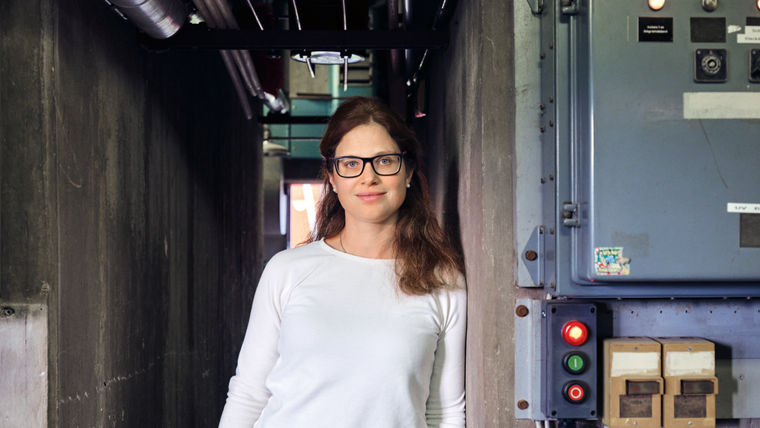The shreds of PET whirling around behind a thick pane of borosilicate glass look a lot like they’re in a snow globe. A stirring unit inside the stainless-steel pressure vessel is driving the polymer flakes through the colorless liquid in an endless dance. The show, which is visible only when a flashlight is shined into it, initially continues unchanged. But after a while the shreds begin to dissolve. After a temperature far above 100°C has been reached and a high pressure has built up inside the vessel, it doesn’t take long for the shreds to completely disappear. The liquid inside the test reactor now has a bluish color. “That’s what usually happens with this raw material, which is strongly colored PET,” says Dr. Jutta Malter, the Laboratory Manager at the Evonik facility in Lülsdorf, a district near Cologne. Unless there is a further purification step, the blue dye will also be present later on in the PET’s monomer component, which the researchers are aiming to separate out by using an alcoholysis process after the sample has cooled off. The dye will be present in only a tiny concentration—but the resulting dimethyl terephthalate, or DMT for short, will also have a slight blue cast.
How can such discolorations be prevented? And what would be the simplest way to remove such impurities from the monomer later on? These are questions that Malter and her team at the Functional Solutions business line are hoping to answer. The answers they come up with will determine the applications for which the recovered material can be used. Their goal is to find a combination of chemicals and technical processes that will make it possible to chemically recycle waste plastics in ways that save energy, are economical, and lead to high-quality applications.
ELEMENTS-Newsletter
Receive exciting insights into Evonik's research and its social relevance - conveniently by e-mail.
RECYCLED PLASTICS ARE IN DEMAND
Dr. Patrick Glöckner is firmly convinced that the time for chemical recycling has come. “Many processes have basically been known for decades,” says Glöckner, an expert on circular economy who works at Evonik.
But only now have these technologies reached the point of maturity where they can soon be implemented on an industrial scale.” The signs have changed, according to Glöckner, who is responsible for Evonik’s Global Circular Plastics Program. “Many customers are looking for products that are as sustainable as possible,” he says. “Even major brand-name companies are increasingly asking for recycled plastics, including PET, for their products.” IKEA has particularly ambitious goals. “One of our ambitions is to use only renewable and recycled materials by 2030 for all products where relevant,” says Raffaele Giovinazzi, who is researching materials recycling as a member of IKEA’s polymer team.
Political developments are supporting the trend toward the use of more recycled plastic. For example, the European Commission has decided that ten million tons of recyclate should be utilized in the EU by 2025. Moreover, all packaging in Europe should be either reusable or recyclable by 2030. The aim is to make “Recycled in the EU” a mark of top quality.
As a result, efforts to implement mechanical and chemical methods for recycling plastics are intensifying all over the world. “We will need both kinds of processes if we want to reach ambitious political goals and create a sustainable circular economy,” Glöckner says. Mechanical recycling is usually the first choice, he adds. “The only problem is that not everything can be mechanically recycled.”


»We’re building a platform technology for recycling various polymers«
PATRICK GLÖCKNER HEAD OF THE GLOBAL CIRCULAR PLASTICS PROGRAM
The composition of some plastics makes them unsuitable for mechanical recycling. These plastics mainly include film packaging for sausage and cheese, which consists of several wafer-thin layers of various plastics. In Germany, such composite films are currently being incinerated because their clear-cut separation is too expensive. Moreover, even easily recyclable plastics such as PET cannot be mechanically recycled without any limitations because, for example, they have been colored. And finally, in every round of recycling the molecular chains become shorter and thus can no longer be used for high-quality applications.
CHAINS BECOME SMALLER MOLECULES
That’s why only about a fourth of recycled PET materials in Germany can be processed into bottles. Another large proportion of recycled PET materials is used to manufacture other products, mainly fleece sweaters and industrial films. “Mechanically recycling these products is even more challenging,” says Glöckner.
Chemical recycling offers a way forward. Unlike mechanical recycling, this process splits the polymer chains of the starting material into monomers. As a result, even polymer material flows that are very dirty, have been colored or contain additives or foreign materials can be recycled as valuable raw materials. The chemical building blocks that are created in this way can then be converted into new polymers for high-quality applications—thus closing the cycle.
However, such processes are only suitable for practical applications if they can be used on an industrial scale. “The reliable availability of plentiful low-value waste feedstock is the key to more chemical recycling,” says IKEA expert Giovinazzi. That’s why one focus of Evonik’s Global Circular Plastics Program is on technologies whose input materials are available in large quantities. In addition, a positive life cycle assessment must be ensured. That’s because processes that are technically feasible are not necessarily good for the environment. The process development of PET methanolysis that Jutta Malter and her six-person team are now working on in Lülsdorf has already made good progress in this direction.

In terms of the chemistry involved, this process is a transesterification,” Malter explains. The PET raw material is combined with a multiple volume of methanol and a catalyst and is then heated. This results in the reaction product DMT and ethylene glycol (EG). If the starting materials are pure and the reaction conditions are ideal, this is not a particularly complicated reaction, says Malter. “For chemists who prefer to synthesize complex molecules, this is probably not the right task.” The challenges arise after the reaction in the test tube is over, she adds. Malter’s aim is to develop a cost-efficient process that uses various kinds of PET starting materials to produce high yields of DMT and EG that are as pure as possible. And of course the entire process should have an optimized life cycle assessment.

ONE PROCESS—MANY POSSIBILITIES
One important fixed point of Malter’s trials is the catalyst, and sodium methylate is her catalyst of choice. This alkoxide, which Evonik has been producing in Lülsdorf for a long time, is mainly used today for the production of biodiesel. The efficient PET methanolysis is expected to also open up an interesting new sales market for this business line.
Since 2014, the researchers have tested all the possible combinations of widely used plastics with the alkoxides produced at the location in order to learn more about potential recycling processes. One of the most promising pairings has been the combination of PET methanolysis with sodium methylate.
Another advantage of this reaction is that Evonik could make use of the resulting DMT in-house. “By using this DMT we could produce plasticizers that are even more sustainable,” says Michael Graß from Evonik’s Performance Intermediates business line. His unit is already producing a plasticizer made of dimethyl terephthalate today. “An alternative consisting of DMT recyclate would have the advantage of possessing the same properties as a conventionally manufactured product,” Graß says. “We wouldn’t have to explain a new molecule to the customers.” Besides, the authorizations under the EU’s REACH chemicals regulation could continue to be used unchanged.
Graß emphasizes that the success of a sustainable plasticizer would depend on the establishment of a competitive price. After all, every recycled raw material competes with the price that is asked for a new petroleum-based material.

And of course the DMT used for such an application shouldn’t have a blue cast either. Jutta Malter is now responsible for meeting all of these requirements. “That is certainly technically feasible,” she says. But there’s still a whole list of details to investigate. Does the process require one, two, or three purifiction steps—or none at all, depending on the pressure and the temperature? Can ultrapure DMT also be produced using other PET sources that might be less expensive? How strongly do the impurities in each starting material affect the reaction product?
And after all these questions have been answered, Thomas Richter will be asking new ones. Together with other experts from the Process Technology & Engineering unit, he is working to develop efficient and scalable processes for exploiting the economic potential of chemical recycling for Evonik. The unit expects its efforts to ultimately result in a viable large-scale plant. “For most reactions, the catch is that they can’t be scaled up one-to-one from laboratory dimensions to industrial production,” says Richter.

TOWARD A PLATFORM TECHNOLOGY
Like Jutta Malter, in his research Richter is looking for the optimal setup for PET methanolysis. “Simply using bigger stirrer tanks is not going to work,” he says. The reaction would take too long, and the process would be too expensive relative to the achievable yield. It would also be problematic to increase the pressure in order to accelerate the reaction. “The associated follow-up costs would be too high,” he explains.
The experts on the team, who come from various units at Evonik, believe that developing the best process requires the construction of a pilot plant. On this basis they could make different offers to customers later on: Do they need all of the process know-how for their own plants—or only the ideal catalyst? Patrick Glöckner is already thinking beyond the PET recycling process. “We’re using the knowledge we are accumulating here to create a platform technology,” he says. “It can be used not only to recycle other classes of polymers but also to produce other monomers.”
Glöckner points out that Evonik wants to play as large a role as possible in making recovery technologies faster, more efficient, and less expensive. “The ultimate goal is to leave the oil in the ground.”
Recycling raw material
The plastic polyethylene terephthalate (PET) has so far been recycled mechanically. The collected material is shredded, cleaned, melted down - and remolded into bottles. However, heavily contaminated or colored PET cannot be processed in this way. This is where chemical (feedstock) recycling comes into play..



